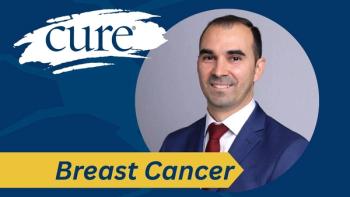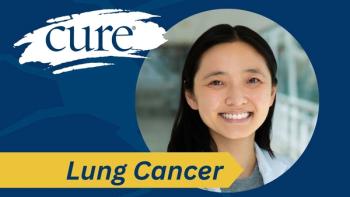
Side Effects to Expect While on Datroway Treatment for Lung Cancer
Key Takeaways
- Datroway is FDA-approved for EGFR-mutated NSCLC, with common side effects like mild nausea and fatigue, which are generally manageable.
- Less common side effects include stomatitis, eye irritation, and interstitial lung disease, requiring careful monitoring and management.
Beginning treatment for your lung cancer often brings questions surrounding what side effects will be experienced, according to Dr. Jacob Sands.
Beginning treatment for your cancer often also brings questions surrounding what side effects will be experienced, and how bad they will be. Following the June 2025 U.S. U.S.
While some side effects like mild nausea or fatigue are relatively common and manageable, others are rarer and require close monitoring, Sands explained. He also broke down which side effects are most likely, which are less common, and how the care team works with patients to minimize discomfort while maximizing benefit.
Sands is a physician at the Dana-Farber Cancer Institute in Boston, where he also serves as associate chief of the Lowe Center for Thoracic Oncology and oncology medical director of International Patient Center. Additionally, he is an assistant professor at Harvard Medical School.
CURE: What are the most common side effects of Datroway, and how are they typically managed by the care team?
Sands: There are multiple side effects, which we expect with any of our treatments. The question is, among the multiple side effects, how many of them were substantial or meaningful? I don't use that word lightly. I understand that one day of not feeling like eating as much is not something I want to happen to anybody. That could be a grade 1 or a mild nausea, for example. When we look at the data for this, we see the percentage of people who had nausea. If once every three weeks, someone has a day where they feel like, “My stomach feels a little off, I don't feel like eating as much,” but they carry on and are active throughout the day, that counts.
I say that because when we're looking at the data for this, I think we have to keep that in mind. When I talk with patients and say, “Here are all the things that could happen on this drug,” I recognize that most people are expecting that they're going to have severe symptoms of all of those things. Thankfully, that is not how this goes, and the balance here is to use the drug in a way that's helping while minimizing how much it affects people. That being said, some nausea occurs with this, and for many patients, that is very mild and lasts for a day or two. They carry on with their lives and are active. For others, it can be more severe, and if that ends up being more severe, then we adjust the dose, reevaluate, or consider what other medications we can use to prevent nausea. Thankfully, it's minimal for that to be more severe.
There can be fatigue, and again, that's usually mild for some days afterward. I don't think I've actually seen a case where that's severe, but if it occurred, you would re-evaluate and see what you can do.
What are some of the less common or unique side effects associated with Datroway, and how do you typically monitor and manage them in clinical practice?”
The things with [Datroway] that are more unique, which is not to say that there aren't other drugs that cause it, but the majority of our treatments for non-small cell lung cancer don't cause these three things that make them stand out.
The first is stomatitis or mucositis, which is inflammation in the mucus membranes in your mouth. For the majority of people, this was considered very low and mild, meaning they didn't actually feel it. We just see something on examination, but there were people who felt it. If they feel it for a day, that's one thing. If it goes on for weeks, obviously, that's another. For anyone who's having those kinds of symptoms, we would want them to resolve before they get to the next dose. We do have some things we can do to help prevent or minimize those symptoms, but for some people, it can be a lot. Thankfully, these are lower numbers; however, when that happens and if it's not resolving, then we would typically say, “Once it resolves, let's lower the dose.” I have seen that work well for some patients. So that's one: stomatitis and mucositis.
Another is something on the surface of the eye where people just get a little irritation. It's kind of like dry eye, but it needs to be evaluated. I have not personally seen anyone where that became a bigger problem. Using preservative-free lubricating eye drops is something that seems to help a lot for most patients. Anyone who's experienced things like that should see an ophthalmologist or optometrist to get an evaluation and track it. I've not personally seen that be a problem for anybody, and those eye drops tend to help. Again, you need to see somebody. Thankfully, that also was a lower number.
The other thing, which is a particularly low number but something we need to watch for, is something called interstitial lung disease, or inflammation in the lungs. We're getting scans anyway and monitoring, and it's not uncommon to see some waxing and waning inflammatory findings in the lungs. We have to consider the possibility of the drug causing that in all cases as well. If that comes up and it really seems like it's from the drugs, then we would often start steroids. In this cohort of patients that had tumors with an EGFR mutation, 4% of patients in the study had any of this kind of inflammation in the lungs that looked to be from the drug. There was one patient that had that a bit more severely but recovered. So it's something to watch for.
Anytime I see a scenario where I think, “Oh, that might be inflammation in the lungs from the drug,” it's also important to say, “Okay, but what else could it be?” Let's not miss something because we're just thinking of that. Thankfully, that's also a lower number.
Are there any tests or markers that patients need to undergo before starting Datroway to ensure it’s the right option for them?
This is a discussion to have with your physician, of course, as far as what’s important in your specific scenario. The challenge of the science of oncology is taking all of the science, the data from the trials, the outcomes, how things worked, the treatment benefits, and the risks or side effects, and weighing it all out to determine an individual's best option, or what the risks and benefits are for an individual.
To individualize all of this data is to take into account what other diseases there might be, what other medications people are on, or what people's preferences are and what they want from their treatment.
One thing about Datroway is it's a once-every-three-week infusion. I think from a timeframe that works well for a lot of patients, and the benefits of the treatment, when compared to the alternative which is chemotherapy, broadly outweigh the risks as I’ve described them. So, this is really an important consideration for almost every patient. That's a discussion for people to have with their oncologists about what makes the most sense for them right now. In tumors with an EGFR mutation, patients who have previously been treated with targeted therapy as well as the initial chemotherapy are eligible. I think broadly, this is something to consider for the majority of individuals.
Reference
- “Datopotamab Deruxtecan in Advanced or Metastatic Non–Small Cell Lung Cancer With Actionable Genomic Alterations: Results From the Phase II TROPION-Lung05 Study,” by Dr. Jacob Sands, et al., Journal of Clinical Oncology.
Transcript has been edited for clarity and conciseness.
For more news on ancer updates, research and education,





